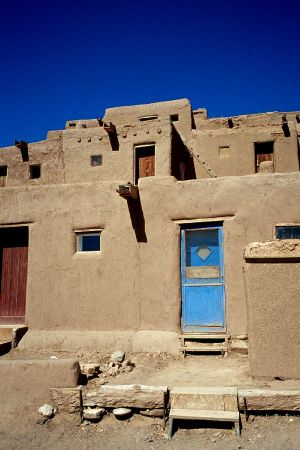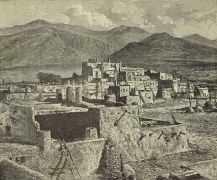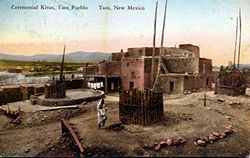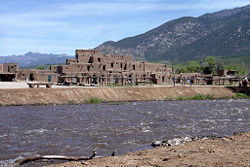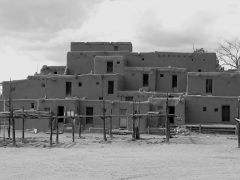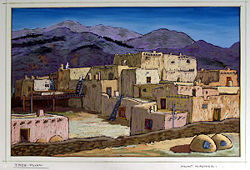Difference between revisions of "Taos Pueblo" - New World Encyclopedia
Mary Anglin (talk | contribs) |
Mary Anglin (talk | contribs) |
||
| Line 56: | Line 56: | ||
Taos Pueblo was first visited by [[Europe]]ans in 1540. In 1598 Mission San Gerónimo de Taos was founded. Rebuilt on three separate occasions, the mission was officially abandoned in 1846. | Taos Pueblo was first visited by [[Europe]]ans in 1540. In 1598 Mission San Gerónimo de Taos was founded. Rebuilt on three separate occasions, the mission was officially abandoned in 1846. | ||
| − | The plotting of the [[Great Pueblo Revolt]] of 1680 was centered in Taos Pueblo. A response to [[Spain|Spanish]] mistreatment of the [[Native American|Native peoples]], this regional uprising drove the Spanish out of [[New Mexico]] until 1692. The Pueblo endured a [[Siege of Pueblo de Taos|siege]] by [[U.S.]] forces in 1847, and experienced the return by [[Richard Nixon|President Nixon]] in 1970 of the Pueblo's 48,000 acres (194 km²) of [[mountain]] land taken by President [[Theodore Roosevelt]] and designated as the [[Carson National Forest]] | + | The plotting of the [[Great Pueblo Revolt]] of 1680 was centered in Taos Pueblo. A response to [[Spain|Spanish]] mistreatment of the [[Native American|Native peoples]], this regional uprising drove the Spanish out of [[New Mexico]] until 1692. The Pueblo endured a [[Siege of Pueblo de Taos|siege]] by [[U.S.]] forces in 1847, and experienced the return by [[Richard Nixon|President Nixon]] in 1970 of the Pueblo's 48,000 acres (194 km²) of [[mountain]] land taken by President [[Theodore Roosevelt]] in 1906 and designated as the [[Carson National Forest]].<ref>Bob Julyan and Tom Till. 1998. ''New Mexico's wilderness areas: the complete guide''. [Englewood, Colo.]: Westcliffe Publishers. ISBN 9781565792913</ref> |
| + | |||
| + | Blue Lake, which the people of the Pueblo traditionally consider [[sacred]], was included in this return of Taos land. The re-acquisition of the sacred Blue Lake is considered the most important event in its history due to the spiritual belief that the Taos natives originated from the lake itself. Its return is considered a tribute to the tenacity of Pueblo leaders and to the community's commitment to guarding its lands for the spiritual, cultural and economic health of the Pueblo. The return of this land capped a long history of struggle.<ref>''Taos Pueblo''. [http://taospueblo.com/about.php About Taos Pueblo] Retrieved December 17, 2008.</ref> An additional 764 acres south of the ridge between Simpson Peak and Old Mike Peak and west of Blue Lake were transferred back to the Pueblo in 1996.<ref>''Bulk Resource Organization''. [http://bulk.resource.org/gpo.gov/laws/104/publ333.104.pdf PUBLIC LAW 104–333—NOV. 12, 1996] Retrieved December 17, 2008.</ref> | ||
==Archeological site== | ==Archeological site== | ||
Revision as of 05:10, 17 December 2008
| Pueblo de Taos* | |
|---|---|
| UNESCO World Heritage Site | |
| State Party | |
| Type | Cultural |
| Criteria | iv |
| Reference | 492 |
| Region** | Europe and North America |
| Inscription history | |
| Inscription | 1992 (16th Session) |
| * Name as inscribed on World Heritage List. ** Region as classified by UNESCO. | |
Taos Pueblo (or Pueblo de Taos) is an ancient pueblo belonging to a Taos (Northern Tiwa) speaking Native American tribe of Pueblo people. It is approximately 1000 years old and lies about 1 mile (1.6 km) north of the modern city of Taos, New Mexico, USA. The Red Willow Creek, or Rio Pueblo, is a small stream which flows through the middle of the pueblo from its source in the Sangre de Cristo Range. A reservation of 95,000 acres (384 km²) is attached to the pueblo, and about 1,900 people live in this area[1].
Taos Pueblo is a member of the Eight Northern Pueblos. The Taos community is known for being one of the most secretive and conservative pueblos.
Taos Pueblo's most prominent architectural feature is a multi-storied residential complex of reddish-brown adobe divided into two parts by the Rio Pueblo. According to the Pueblo's Web site, it was probably built between 1000 and 1450 C.E. It was designated a National Historic Landmark on October 9, 1960, and in 1992 became a UNESCO World Heritage Site. As of 2006, about 150 people live in it full-time.
The pueblo is inhabited and consists of impressive adobe two to five-story residential blocks, many still accessible only by ladder, the original defensive wall, kivas and the ruins of the mission.
Additional World Heritage Sites honoring the Pueblo peoples are Casas Grandes in northern Mexico, Mesa Verde in southwest Colorado, and Chaco Culture in northwest New Mexico.
"Criterion iv : Taos is a remarkable example of a traditional type of architectural ensemble from the pre-Hispanic period of the Americas unique to this region which has successfully retained most of its traditional forms up to the present day. Thanks to the determination of the latter-day Native American community, it appears to be successfully resisting the pressures of modern society."
Name
In the Taos language, the pueblo is referred to as "the village". The proper name of the Taos Pueblo is ȉałopháymųp’ȍhə́othə̀olbo "at red willow canyon mouth" (or ȉałopháybo "at the red willows" for short); however, this name is more commonly used in ceremonial contexts and is less common in everyday speech.
The name Taos in English was borrowed from Spanish Taos. Spanish Taos is believed to be a borrowing of Taos tə̂o- "village" which was heard as tao to which the plural -s was added although in the modern language Taos is no longer a plural noun. The once popular explanation that the Spanish Taos came from tao "cross of the order of San Juan de los Cabelleros" (from Greek tau) is unlikely.[2][3]
History
| Taos (t’óynemą) |
|---|
| Total population |
| 1,000 (1990 census) |
| Regions with significant populations |
| United States (New Mexico) |
| Languages |
| Taos, English, Spanish |
| Religions |
| Taos religion, Christianity |
| Related ethnic groups |
| other Kiowa-Tanoan peoples |
The Pueblo People are a diverse group of Native Americans once spread throughout a wide geographical range of northern Mexico and the Southwestern United States. Today their descendants reside mainly in New Mexico, Texas, and Arizona in the U.S., and in the Mexican state of Chihuahua. They have traditionally subsisted on agriculture.
Located in the valley of a small tributary of the Rio Grande, Taos Pueblo is an exceptionally well-preserved pueblo in the northernmost reaches of Pueblo territory. It comprises a group of dwelling places and ceremonial centers representative of a culture largely derived from the traditions of the prehistoric Anasazi tribes.
Most archeologists believe that the Taos Indians, along with other Pueblo Indians who eventually settled along the Rio Grande, had migrated from the Four Corners region, whose ancient dwellings had been inhabited by the Anasazi. The cultures there went into an irreversible decline, and in the late 13th century major sites like Mesa Verde and Chaco Canyon were abandoned, perhaps due to major climatic changes including a long drought. It is believed that Taos appeared before 1400, following the disappearance of the Anasazi tribes from the Four Corners region.
The communities of the Anasazi were characterized by common social and religious structures. Their traditional agricultural practices perfected during the classical period, and a systematic use of irrigation, were used.
Taos Pueblo was first visited by Europeans in 1540. In 1598 Mission San Gerónimo de Taos was founded. Rebuilt on three separate occasions, the mission was officially abandoned in 1846.
The plotting of the Great Pueblo Revolt of 1680 was centered in Taos Pueblo. A response to Spanish mistreatment of the Native peoples, this regional uprising drove the Spanish out of New Mexico until 1692. The Pueblo endured a siege by U.S. forces in 1847, and experienced the return by President Nixon in 1970 of the Pueblo's 48,000 acres (194 km²) of mountain land taken by President Theodore Roosevelt in 1906 and designated as the Carson National Forest.[4]
Blue Lake, which the people of the Pueblo traditionally consider sacred, was included in this return of Taos land. The re-acquisition of the sacred Blue Lake is considered the most important event in its history due to the spiritual belief that the Taos natives originated from the lake itself. Its return is considered a tribute to the tenacity of Pueblo leaders and to the community's commitment to guarding its lands for the spiritual, cultural and economic health of the Pueblo. The return of this land capped a long history of struggle.[5] An additional 764 acres south of the ridge between Simpson Peak and Old Mike Peak and west of Blue Lake were transferred back to the Pueblo in 1996.[6]
Archeological site
| Taos Pueblo | |
|---|---|
| (U.S. National Historic Landmark District) | |
| | |
| Nearest city: | Taos, New Mexico |
| Added to NRHP: | October 15, 1966 |
| Reference #: | 66000496 [7] |
| Governing body: | Native American tribal government |
A number of the Pueblo settlements established in the late 13th and early 14th centuries in the valleys of the Rio Grande and its tributaries have survived to the present. Exceptional among these is Taos, in the fact that it has retained the original layout and distinctive style of architecture virtually intact. This provides an illustration of the traditional way of life and community characteristics of its ancient inhabitants.
The village today appears at first glance to conform with the description given in 1776 by Fray Francisco Atanasio Dominguez. However, numerous modifications can be observed.[8] On the village's west side, the missionaries’ convent and church lie in ruins. During the nineteenth century a new church was built on the west of the north plaza. The original form and outline of the adobe dwellings remain, but details have been changed. Exterior doors are now common, as are windows which were once small and sparse. This reflects the acculturation of European traits, as well as the lessening of the structures' use as defensive fortifications. Ovens were traditionally located only outdoors, but fireplaces have been added inside the living quarters.[8]
While the social and economic climate have engendered such changes, a policy exists mandating all repair and reconstruction work be carried out using traditional techniques and materials that are harmonious with the original structures.
Main structure
The north-side Pueblo is said to be one of the most photographed and painted buildings in the Western Hemisphere. It is the largest multi-storied Pueblo structure still existing. It is made of adobe walls that are often several feet thick. Its primary purpose was for defense. Up to as late as 1900, access to the rooms on lower floors was by ladders on the outside to the roof, and then down an inside ladder. In case of an attack, outside ladders could easily be pulled up.
The homes in this structure usually consist of two rooms, one of which is for general living and sleeping, and the second of which is for cooking, eating, and storage. Each home is self-contained; there are no passageways between the houses. Taos Indians made little use of furniture in the past, but today they have tables, chairs, and beds. In the Pueblo, electricity, running water, and indoor plumbing are prohibited.
The pueblo wall completely encloses the village except at the entrance as a symbol of the village boundaries. Now rather short, the wall was once much taller for protection against surrounding tribes. The river running through the pueblo serves as the primary source for drinking and cooking water for village residents. In the winter, the river never completely freezes although it does form a heavy layer of ice. Because the river water moves so swiftly, the ice can be broken to obtain the fresh water beneath.
Site management
Administration of Taos Pueblo is vested in the Taos tribe, which is deeply conscious of its heritage and of the material expression of that heritage in the buildings of the settlement. It has a comprehensive and well conceived Preservation Project, headed by a very competent Director, who is a member of the Taos tribe. Restoration work is carried out by his team, who are all members of the tribe, with scrupulous respect for traditional materials and techniques. Although the self-governing Indian community maintains its identity in face of the city of Taos, which was founded after 1786 further downstream, two dangers threaten the medium-term future of this traditional human settlement. First, the pueblo of Taos has tended to become a seasonal habitat reserved for ceremonial functions, with most of the population living permanently in what were formerly summer residences situated outside the enclosure, which have been provided with the modern facilities that are not permitted within the main pueblo. Secondly, the pueblo, which has a Visitor’s Centre, is increasingly assuming the role of a tourist attraction.
Spiritual community
Three religions are represented in the Pueblo: Christianity, the aboriginal religion, and the Native American Church. Most of the Indians are Roman Catholic. Saint Jerome, or San Geronimo, is the patron saint of the pueblo....
The deep feeling of belonging to a community, summed up in their phrase, “we are in one nest,” has held the Taos people together. Both men and women are expected to offer their services or “community duties,” when needed. One should be cooperative and never allow their own desires to be destructive of the community’s interest. One of Taos’s strongest institutions is the family. Descent on both the father and the mother’s side of the family is equally recognized. Each primary family lives in a separate dwelling so when a couple gets married, they move to their own home. With relatives so near by, everyone is available to help care for the children. The elderly teach the young the values and traditions that have been handed down, which protects the integrity of the Taos culture.
Additional images
- Taos Pueblo
Taos Pueblo Church (1942) by Ansel Adams
Notes
- ↑ Who lives in the Pueblo? (scroll down)
- ↑ William Jones. 1960. Origin of the place name Taos. Anthropological Linguistics, 2 (3), 2-4
- ↑ George L.Trager. 1960. The name of Taos, New Mexico. Anthropological Linguistics, 2 (3), 5-6.
- ↑ Bob Julyan and Tom Till. 1998. New Mexico's wilderness areas: the complete guide. [Englewood, Colo.]: Westcliffe Publishers. ISBN 9781565792913
- ↑ Taos Pueblo. About Taos Pueblo Retrieved December 17, 2008.
- ↑ Bulk Resource Organization. PUBLIC LAW 104–333—NOV. 12, 1996 Retrieved December 17, 2008.
- ↑ National Register Information System. National Register of Historic Places. National Park Service (2006-03-15).
- ↑ 8.0 8.1 UNESCO World Heritage Centre. Advisory Body Evaluation Retrieved December 17, 2008.
ReferencesISBN links support NWE through referral fees
- Bodine, John J. 1977. Taos Pueblo: a walk through time : a visitor's guide to the pueblo, its people, and their customs and their long history. Santa Fe, N.M.: Lightning Tree. ISBN 9780890160381
- Keegan, Marcia. 1991. The Taos Pueblo and its sacred Blue Lake. Santa Fe, N.M.: Clear Light Publishers. ISBN 9780940666122
- National Park Service. Taos Pueblo Retrieved December 16, 2008.
- TaosWebb. Taos Pueblo - A thousand years of tradition Retrieved December 16, 2008.
- UNESCO World Heritage Centre. Pueblo de Taos Retrieved December 17, 2008.
- Wood, Nancy C. 1989. Taos pueblo. New York: Knopf. ISBN 9780394560328
External links
All Links Retrieved December 16, 2008.
- Webcam of sacred Taos Mountain
- Maps and aerial photos
- Street map from Google Maps or Yahoo! Maps
- Topographic map from TopoZone
- Satellite image from Google Maps or Microsoft Virtual Earth
Cahokia | Carlsbad Caverns | Chaco Culture | Everglades | Grand Canyon | Great Smoky Mountains | Hawaii Volcanoes | Independence Hall | Kluane / Wrangell-St. Elias / Glacier Bay / Tatshenshini-Alsek (w/ Canada) | La Fortaleza and San Juan National Historic Site, Puerto Rico | Mammoth Cave | Mesa Verde | Monticello and University of Virginia | Olympic | Pueblo de Taos | Redwood | Statue of Liberty | Waterton Glacier International Peace Park (w/ Canada) | Yellowstone | Yosemite
Credits
New World Encyclopedia writers and editors rewrote and completed the Wikipedia article in accordance with New World Encyclopedia standards. This article abides by terms of the Creative Commons CC-by-sa 3.0 License (CC-by-sa), which may be used and disseminated with proper attribution. Credit is due under the terms of this license that can reference both the New World Encyclopedia contributors and the selfless volunteer contributors of the Wikimedia Foundation. To cite this article click here for a list of acceptable citing formats.The history of earlier contributions by wikipedians is accessible to researchers here:
The history of this article since it was imported to New World Encyclopedia:
Note: Some restrictions may apply to use of individual images which are separately licensed.
